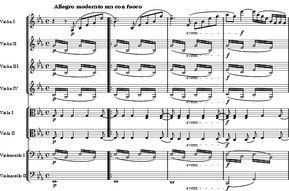Octet (Mendelssohn)
Felix Mendelssohn's Octet in E-flat major, Op. 20, was composed in the autumn of 1825 and completed on October 15,[1] when the composer was 16. He wrote the octet as a birthday gift for his friend and violin teacher Eduard Ritz; it was slightly revised in 1832 before the first public performance on 30 January 1836 at the Leipzig Gewandhaus.[2] Conrad Wilson summarizes much of its reception ever since: "Its youthful verve, brilliance and perfection make it one of the miracles of nineteenth-century music."[3]
| Octet in E-flat major | |
|---|---|
| by Felix Mendelssohn | |
 The beginning | |
| Key | E-flat major |
| Catalogue | Op. 20 |
| Composed | 1825 |
| Dedication | Eduard Ritz |
| Performed | 30 January 1836 |
| Duration | about 30 minutes |
| Movements | four |
| Scoring | double string quartet |
Structure
The work comprises four movements:
- Allegro moderato ma con fuoco (E-flat major)
- Andante (C minor)
- Scherzo: Allegro leggierissimo (G minor)
- Presto (E-flat major)
A typical performance of the work lasts around thirty minutes, with the first movement usually comprising roughly half of this.
The scherzo, later scored for orchestra as a replacement for the minuet in the composer's First Symphony at its premiere, is believed to have been inspired by a section of Goethe's Faust entitled "Walpurgis Night's Dream".[4] Fragments of this movement recur in the finale, as a precursor to the "cyclic" technique employed by later 19th-century composers. The entire work is also notable for its extended use of counterpoint, with the finale, in particular, beginning with an eight-part fugato. In this section, Mendelssohn quotes the melody of "And he shall reign forever and ever" from the "Hallelujah Chorus" of Handel's Messiah.[5][6]
The work has been compared to Louis Spohr's 1823 Double Quartet No. 1 in D minor, Op. 65.[7]
Instrumentation
The original score is for a double string quartet with four violins and pairs of violas and cellos. Mendelssohn instructed in the public score, "This Octet must be played by all the instruments in symphonic orchestral style. Pianos and fortes must be strictly observed and more strongly emphasized than is usual in pieces of this character."[2]
The piece is sometimes played by full string sections using more players for each part as well as an added double bass part which usually (but not always) doubles the second cello part an octave lower. For example, Arturo Toscanini created such a version for a performance with the NBC Symphony Orchestra in 1947. More recently in 2009, conductor Yoon Jae Lee made a transcription of the first, second, and last movements for full orchestra.[8]
The composer also transcribed the piece as a piano duet with violin and cello ad. lib. and orchestrated the third movement Scherzo (with compositional alterations) as an alternative third movement to his Symphony No. 1 in C minor.
References
- Todd, R. Larry (2003). Mendelssohn: a life in music. Oxford University Press US. p. 148. ISBN 0-19-511043-9.
- "Octet in E-flat major for string, Op. 20" (PDF). NY Philharmonic. Retrieved 13 June 2011. – NY Philharmonic program notes PDF
- Wilson, Conrad (2005). Notes on Mendelssohn: 20 Crucial Works. Wm. B. Eerdmans Publishing. ISBN 0-8028-2995-3.
- Program notes Archived 2013-06-16 at the Wayback Machine from a concert at the Kennedy Center
- LA Phil, Program notes. Retrieved 19 October 2017
- R Larry Todd, Mendelssohn, p. 152. Retrieved 19 October 2017
- Hefling, Stephen E. (2003). Nineteenth-century chamber music. Nineteenth-century chamber music. p. 181. ISBN 0-415-96650-7.
- "Review: Reduced Baltimore contingent pleases at Longwood". Philly.com. Retrieved 11 April 2013.
External links
- String Octet: Scores at the International Music Score Library Project (IMSLP)
- Complete performance of the Octet by the Musicians from Marlboro from the Isabella Stewart Gardner Museum in MP3 format. (32:22)
- Another complete performance of the Octet by the Prazak & Zemlinsky Quartets at the Festival Wissembourg - September 4th 2013 (35:36)
- Complete Octet played by one single person - posted on YouTube November 26th 2015 (32:36)